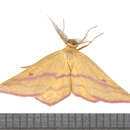Conservation Status
provided by University of Alberta Museums
Not of concern.
- license
- cc-by-nc
- copyright
- University of Alberta Museums
Cyclicity
provided by University of Alberta Museums
Alberta flight dates range from mid July to late August.
- license
- cc-by-nc
- copyright
- University of Alberta Museums
Distribution
provided by University of Alberta Museums
Quebec west to southeastern Alberta, with a single record from Ft. Smith, NWT (McGuffin 1967).
- license
- cc-by-nc
- copyright
- University of Alberta Museums
General Description
provided by University of Alberta Museums
The tan forewings and ochre hindwings, with two broad pink transverse bands and border, are unmistakable. The male antennae with its very long pectinations add to the uniqueness of this elegant moth.
- license
- cc-by-nc
- copyright
- University of Alberta Museums
Habitat
provided by University of Alberta Museums
Prairie grasslands and shrublands.
- license
- cc-by-nc
- copyright
- University of Alberta Museums
Life Cycle
provided by University of Alberta Museums
The egg hatches in about seven days, and larvae go through five instars and mature in 28 to 30 days. The pupa is light yellow-green and light brown with a purplish dorsal line (McGuffin 1967). Adults come to light. There may be two flights annually in the southern prairies.
- license
- cc-by-nc
- copyright
- University of Alberta Museums
Trophic Strategy
provided by University of Alberta Museums
Larvae feed on muse-ear chickweed (Cerastium), chickweed (Stellaria) and several species of knotweed (Polygonum) (Handfield 1999).
- license
- cc-by-nc
- copyright
- University of Alberta Museums

